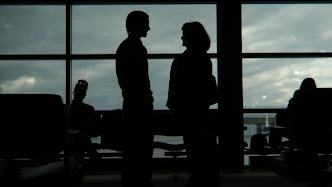Topic #1: 'From Stage to Screen'
Before I begin, I realized in the wake of Cole and Jeremy's introductions that I didn't formally introduce myself. What a travesty!
In brief: my name is John Klein, and I'm the producer and director of photography for Separation Anxiety. I work in Chicago mostly as a freelance cinematographer and all-purpose crew member, and have written a few screenplays here and there as well, namely our flagship effort Glass City, on which I also served as cinematographer under director Cole Simon. I am, in all ways, a nerd, a geek, a lover of film and filmmaking in all its forms. I love the melding of the art and the science of movies, and I am blessed beyond words to have been able to do this for a living for close to three years now. It's better than a real job, and it's better than a hobby. It's my life.
Now, a brief word about what is to follow on our blog. Cole, Jeremy and I are avid bloggers, but Glass City Films' first attempt at a blog for Glass City was a bit of a failure. In its wake, we decided that the reasons were (a) a lack of scheduling and upkeep, and (b) a lack of an overarching goal for the blog. What were we trying to achieve with it?
So, with that said, our goal for this blog is not just to give you an insider's perspective on the process of making Separation Anxiety or to offer the usual newsfeeds and needs of this film production, but to give you the chance to see what makes this production unique and to learn about the craft of filmmaking at all levels from people who are, for all intensive purposes, both very professional about our craft and yet still relatively new to several elements of the process.
And, to facilitate more of a regiment about blogging, we're going to have a different topic each week, which the three of us will tackle on a weekly basis - me as a DP and producer, Jeremy as a writer and director, and Cole as an actor and an artist.
Thus, this entry's title...
"From Stage To Screen"
Separation Anxiety began as a script for the stage. Jeremy will talk a great deal about the experience of watching his work being performed, much as Cole will talk about the joy of acting as Bailey in the theatrical production prior to his work in the film version. My only experience with the play itself is in my initial reading of the script, when Cole first sent me Separation Anxiety and said it might make a good movie, something on our low-budget scale that we could pull off in the wake of Glass City's successful production.
I fell in love with the script instantly. As a play, the three "plotlines" of Jess/Mr. Palmer, Quinn/Lily, and the flashbacks were written to take place on three areas of the stage, the latter being center stage to separate Jess and Mr. Palmer's dialogue in Bailey's house from Quinn and Lily's dialogue in the airport. It's a clever conceit - had I seen it, I'd probably talk more about it - but what drew me in was the endlessly quotable lines and the strong attention to character. And, in spite of its dialogue-heavy format, it felt visually exciting. Shots and scenes formed in my head simply from the play script, and in the transition to a screenplay, my first edict to Jeremy was that he find a way to merge the strengths of the stage with the potential of the screen.
The first draft of the screenplay had its flaws - far too much dialogue and a tendency to veer into inaccessible prose - but the opening six pages became a stellar montage of character development and imagery that hooked me from the get-go. So many ideas emerged in that first draft which Jeremy had already thought out from concept to completion - constantly cutting back to Bailey readying himself (for his death? for something else?) in his room, having Bailey's "ghost" interject into flashbacks now and again, sound bridges and images and cross-cutting - that I was overwhelmed with excitement for the next version.
New drafts are on the way, and I'm already giddy with anticipation. But the challenge of bringing this script to the screen is a monumental one, and I've seen so many terrific plays turned into boring and humdrum movies. For example, The History Boys is a wondrous script marred in the film version by an inability to let close-ups and visuals speak for themselves. I hear similar criticisms about Doubt and Frost/Nixon, both Oscar contenders this year. Even book translations (i.e. the first two Harry Potter films, Atonement, The Curious Case of Benjamin Button, and countless other adaptations) suffer in the same light: Don't use a paragraph where a sentence will do. In film, visuals sometimes speak volumes where words would have to suffice on the stage. There are greater options for scenery, mise en scene, and even blocking. To wit, the advent of sound in filmmaking made silence all the more effective. Use it.
I've already rambled more than you will probably read for an initial blog entry on any topic, but I look forward to hearing thoughts in the comments below and with Cole and Jeremy's subsequent entries on the subject. Until next week for me, friends!
Regards,
John Klein
Producer/DP, "Separation Anxiety"
www.windycitycamera.com





0 comments:
Post a Comment